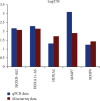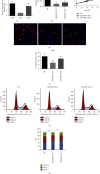Knockdown of lncRNA HOXD-AS2 Improves the Prognosis of Glioma Patients by Inhibiting the Proliferation and Migration of Glioma Cells
- PMID: 36408341
- PMCID: PMC9668444
- DOI: 10.1155/2022/9337647
Knockdown of lncRNA HOXD-AS2 Improves the Prognosis of Glioma Patients by Inhibiting the Proliferation and Migration of Glioma Cells
Retraction in
-
Retracted: Knockdown of lncRNA HOXD-AS2 Improves the Prognosis of Glioma Patients by Inhibiting the Proliferation and Migration of Glioma Cells.Evid Based Complement Alternat Med. 2023 Jul 19;2023:9859158. doi: 10.1155/2023/9859158. eCollection 2023. Evid Based Complement Alternat Med. 2023. PMID: 37501828 Free PMC article.
Abstract
Objective: Increasing studies reported that long noncoding RNAs are involved in regulating glioma progression. However, the specific roles and mechanisms of lncRNAs in glioma remain unclear. Here, we sought to explore the functions of HOXD-AS2 in glioma progression.
Methods: Gene expressions of lncRNAs in 5 normal brain tissue specimens and 5 glioblastoma tissue specimens were detected by gene expression profile chip technology. Bioinformatic analysis was performed to see whether differential expression of lncRNAs played any significant role in glioma occurrence and progression. The relationship between HOXD-AS2 level and clinical prognosis of the patients was analyzed. HOXD-AS2 was specifically interfered with by siRNA technology to observe its effects on U251 cell growth, proliferation, apoptosis, and invasion.
Results: The expression level of HOXD-AS2 gene in glioma was significantly higher than that in the normal brain tissue, which was related to the tumor grade. The level of HOXD-AS2 gene in patients with high-grade glioma was higher than that in patients with low-grade glioma. High expression of HOXD-AS2 gene was a risk factor for poor prognosis of glioma patients. Knocking down the expression of HOXD-AS2 in glioma cell line U251 arrested the cell cycle and reduced the cell proliferation. Furthermore, it could significantly reduce the migration ability of the cells but had no significant effect on the invasion.
Conclusion: HOXD-AS2 is an oncogenic lncRNA associated with the poor prognosis of glioma. Knockdown of HOXD-AS2 may reduce the growth of glioma, which may provide a new avenue for treatment.
Copyright © 2022 Feng Chen et al.
Conflict of interest statement
The authors declare that they have no conflicts of interest.
Figures





Similar articles
-
Long noncoding RNA HOXD-AS2 regulates cell cycle to promote glioma progression.J Cell Biochem. 2019 May;120(5):8343-8351. doi: 10.1002/jcb.28117. Epub 2018 Nov 28. J Cell Biochem. 2019. PMID: 30485495
-
A Positive Feedback Loop of lncRNA HOXD-AS2 and SMYD3 Facilitates Hepatocellular Carcinoma Progression via the MEK/ERK Pathway.J Hepatocell Carcinoma. 2023 Jul 27;10:1237-1256. doi: 10.2147/JHC.S416946. eCollection 2023. J Hepatocell Carcinoma. 2023. PMID: 37533602 Free PMC article.
-
Production and Stabilization of Specific Upregulated Long Noncoding RNA HOXD-AS2 in Glioblastomas Are Mediated by TFE3 and miR-661, Respectively.Int J Mol Sci. 2022 Mar 4;23(5):2828. doi: 10.3390/ijms23052828. Int J Mol Sci. 2022. PMID: 35269968 Free PMC article.
-
Long Non-coding RNA DLGAP1-AS1 and DLGAP1-AS2: Two Novel Oncogenes in Multiple Cancers.Curr Med Chem. 2023;30(25):2822-2834. doi: 10.2174/0929867329666220919114919. Curr Med Chem. 2023. PMID: 36121088 Review.
-
Long non-coding RNA HOXD-AS1 in cancer.Clin Chim Acta. 2018 Dec;487:197-201. doi: 10.1016/j.cca.2018.10.002. Epub 2018 Oct 2. Clin Chim Acta. 2018. PMID: 30290157 Review.
Cited by
-
Retracted: Knockdown of lncRNA HOXD-AS2 Improves the Prognosis of Glioma Patients by Inhibiting the Proliferation and Migration of Glioma Cells.Evid Based Complement Alternat Med. 2023 Jul 19;2023:9859158. doi: 10.1155/2023/9859158. eCollection 2023. Evid Based Complement Alternat Med. 2023. PMID: 37501828 Free PMC article.
-
Interplay of Sphingolipid Metabolism in Predicting Prognosis of GBM Patients: Towards Precision Immunotherapy.J Cancer. 2024 Jan 1;15(1):275-292. doi: 10.7150/jca.89338. eCollection 2024. J Cancer. 2024. PMID: 38164288 Free PMC article.
References
Publication types
LinkOut - more resources
Full Text Sources

